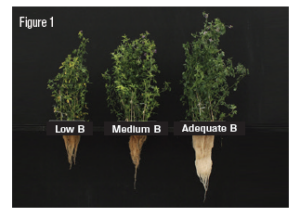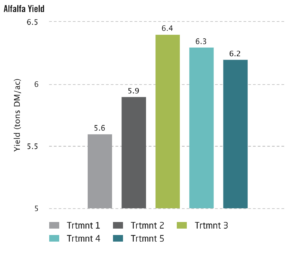OVERVIEW
- Alfalfa removes high rates of potassium (K) from the soil, so MOP is commonly used as a K source to replace nutrient removal.
- In addition to K, adequate soil boron (B) is needed to achieve maximum yields (Figure 1).
- Granular B products can be blended with K, but application of these blends often leads to undesirable distribution.
- Aspire® is a superior B delivery source that combines K with two forms of boron for both early- and late- season needs.
- Additionally, application timings vary across producers (often driven by weather and logistics), so it is important to understand crop responses with different management approaches.
TRIAL DETAILS
Crop: Alfalfa (Medicago sativa)
Years: 2017–2018
Locations: 6 trials (Columbus, WI; Cambridge, WI; and Deford, MI)
Data Source: Field studies conducted by independent third-party researchers.
Experimental Design: Small-plot RCBD with 4 replications.
Cropping Conditions: Trials conformed to local cropping practices and were conducted on an established stand.
TREATMENTS:
Treatment (Trmnt) / Rates / Timing:
Numbered and color-coded to match bar chart. All treatments received a total of 240 lbs K₂O/ac. Trtmnts 2-5 received a total of 2 lbs B/ac. Values in ( ) represent lbs K₂O/ac or lbs B/ac
- MOP (120) applied after 1st and 3rd cutting of harvest year.
- MOP (120) + Granular B (1) blend applied after 1st and 3rd cutting of harvest year.
- Aspire® (120/1) applied after 1st and 3rd cutting of harvest year.
- Aspire® (120/1) applied fall of previous year. Aspire (120/1) applied spring of harvest year.
- Aspire® (240/2) applied fall of previous year.
Application Method: Broadcast

RESULTS

SUMMARY
- Alfalfa yields responded positively to the addition of boron.
- Aspire split-applied after 1st and 3rd cuttings of harvest year increased alfalfa yield 0.8 tons/ac over MOP and 0.5 tons/ac over the MOP+Granular B blend.
- Split applications (120-Fall/120-Spring) of Aspire® and full-rate fall applications (240-Fall) yielded 0.7 ton/ac and 0.6 ton/ac over MOP, respectively.
- The results suggest that while applications of Aspire® after 1st and 3rd cuttings of harvest year provide maximum yield, split application (fall/spring) or full-rate fall applications perform almost as well and demonstrate the flexible application window offered by this fertilizer technology.